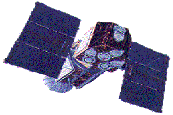|
|
The EUVE Observatory
 The Extreme Ultraviolet Explorer (EUVE), a NASA
explorer class satellite mission, was launched on June 7 1992 and it
operated till January 31 2001. EUVE is entirely dedicated to observations
in the wavelength range from 70 to 760 Å.
The first phase of the mission (six months) was dedicated to an all-sky
survey using the imaging instruments. The second phase instead
is dedicated to pointed observations with mainly the spectroscopic
instruments.
The Extreme Ultraviolet Explorer (EUVE), a NASA
explorer class satellite mission, was launched on June 7 1992 and it
operated till January 31 2001. EUVE is entirely dedicated to observations
in the wavelength range from 70 to 760 Å.
The first phase of the mission (six months) was dedicated to an all-sky
survey using the imaging instruments. The second phase instead
is dedicated to pointed observations with mainly the spectroscopic
instruments.
Mission Characteristics
 Lifetime :
June 7, 1992 - January 31, 2001 Lifetime :
June 7, 1992 - January 31, 2001
 Energy Range : 70-760 Å
Energy Range : 70-760 Å
 Special Features : First dedicated extreme ultraviolet mission
Special Features : First dedicated extreme ultraviolet mission
 Payload :
Payload :
- 2 Wolter-Schwarzschild Type I grazing incidence mirror,
each with an imaging microchannel plate (MCP detector)
(Scanner A & B)
FOV ~5° diameter; two passbands 44-220 Å 140-360 Å
- 1 Wolter-Schwarzschild Type II grazing incidence mirror,
with an imaging microchannel plate (MCP detector)
FOV ~4° diameter; two passbands 520-750 Å 400-600 Å
- 1 Wolter-Schwarzschild Type II grazing incidence mirror
Deep Survey/Spectrometer Telescope. The light is split,
with half of the light fed to:
- An imaging Deep Survey MCP detector
- Three Spectrometers which are each combinations of a grating
and MCP detector:
SW (70-190 Å) MW (140-380 Å)
LW (280-760 Å).
 Science Highlights:
Science Highlights:
- All-sky survey catalog (801 objects)
- EUV first detection of extragalactic objects (e.g. PKS 2155-304)
- Detection of the photospheric emission from stars (e.g. epsilon CMa)
- Quasi Periodic Oscillation detection in the Dwarf Nova SS Cygni
 Archive :
HEASARC hosts catalogs, images, raw data and selected spectra
Archive :
HEASARC hosts catalogs, images, raw data and selected spectra
[EUVE Home]
[All Missions]
[by Time]
[by Energy]
Page authors: Lorella Angelini Jesse Allen
HEASARC Home |
Observatories |
Archive |
Calibration |
Software |
Tools |
Students/Teachers/Public
Last modified: Thursday, 24-Sep-2020 19:08:54 EDT
|
 The Extreme Ultraviolet Explorer (EUVE), a NASA
explorer class satellite mission, was launched on June 7 1992 and it
operated till January 31 2001. EUVE is entirely dedicated to observations
in the wavelength range from 70 to 760 Å.
The first phase of the mission (six months) was dedicated to an all-sky
survey using the imaging instruments. The second phase instead
is dedicated to pointed observations with mainly the spectroscopic
instruments.
The Extreme Ultraviolet Explorer (EUVE), a NASA
explorer class satellite mission, was launched on June 7 1992 and it
operated till January 31 2001. EUVE is entirely dedicated to observations
in the wavelength range from 70 to 760 Å.
The first phase of the mission (six months) was dedicated to an all-sky
survey using the imaging instruments. The second phase instead
is dedicated to pointed observations with mainly the spectroscopic
instruments.

